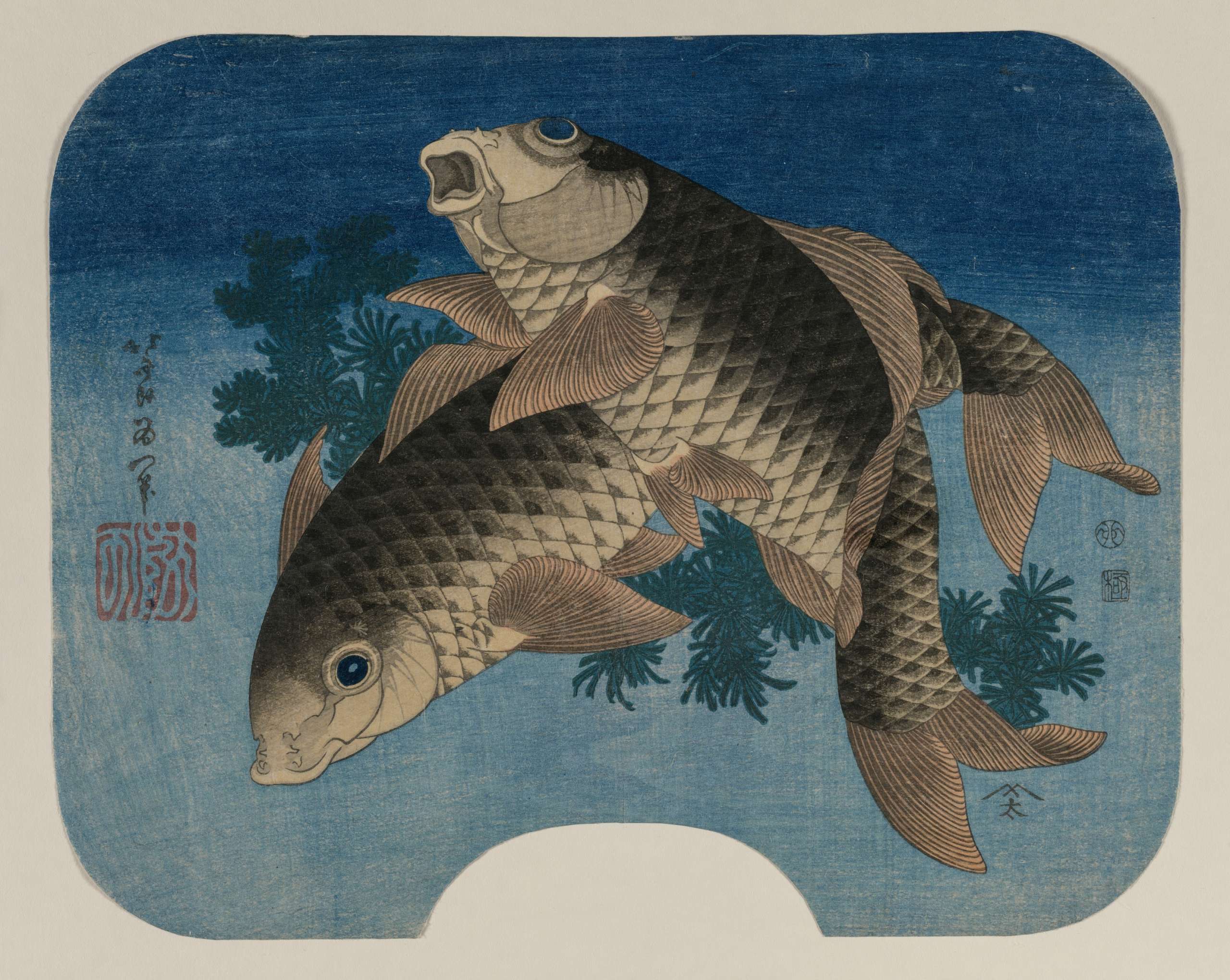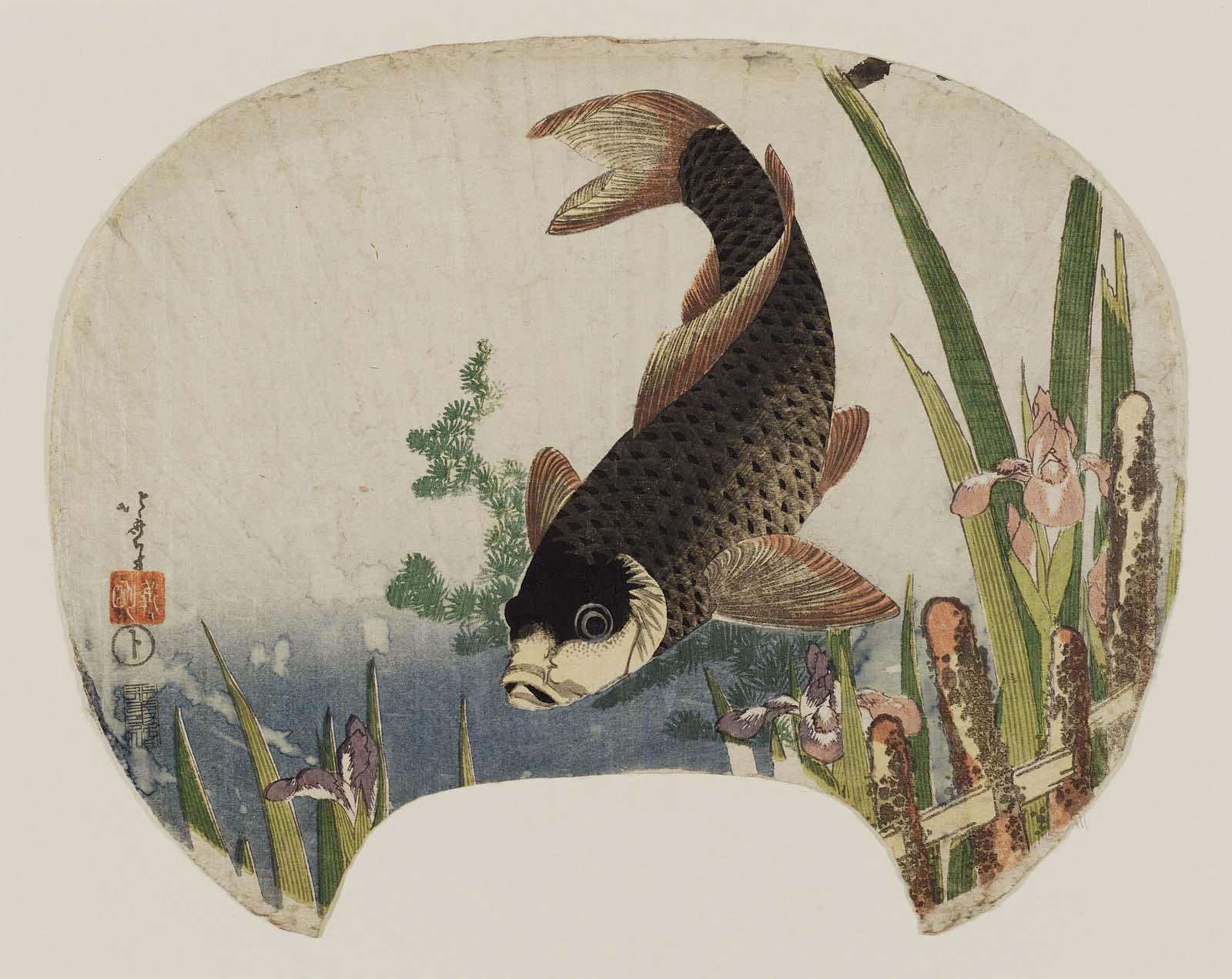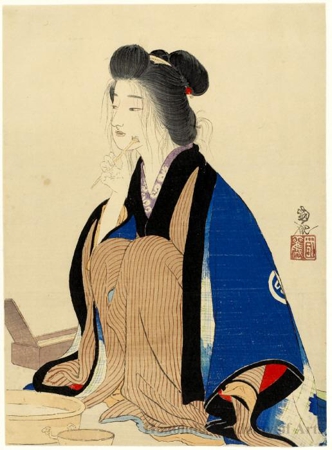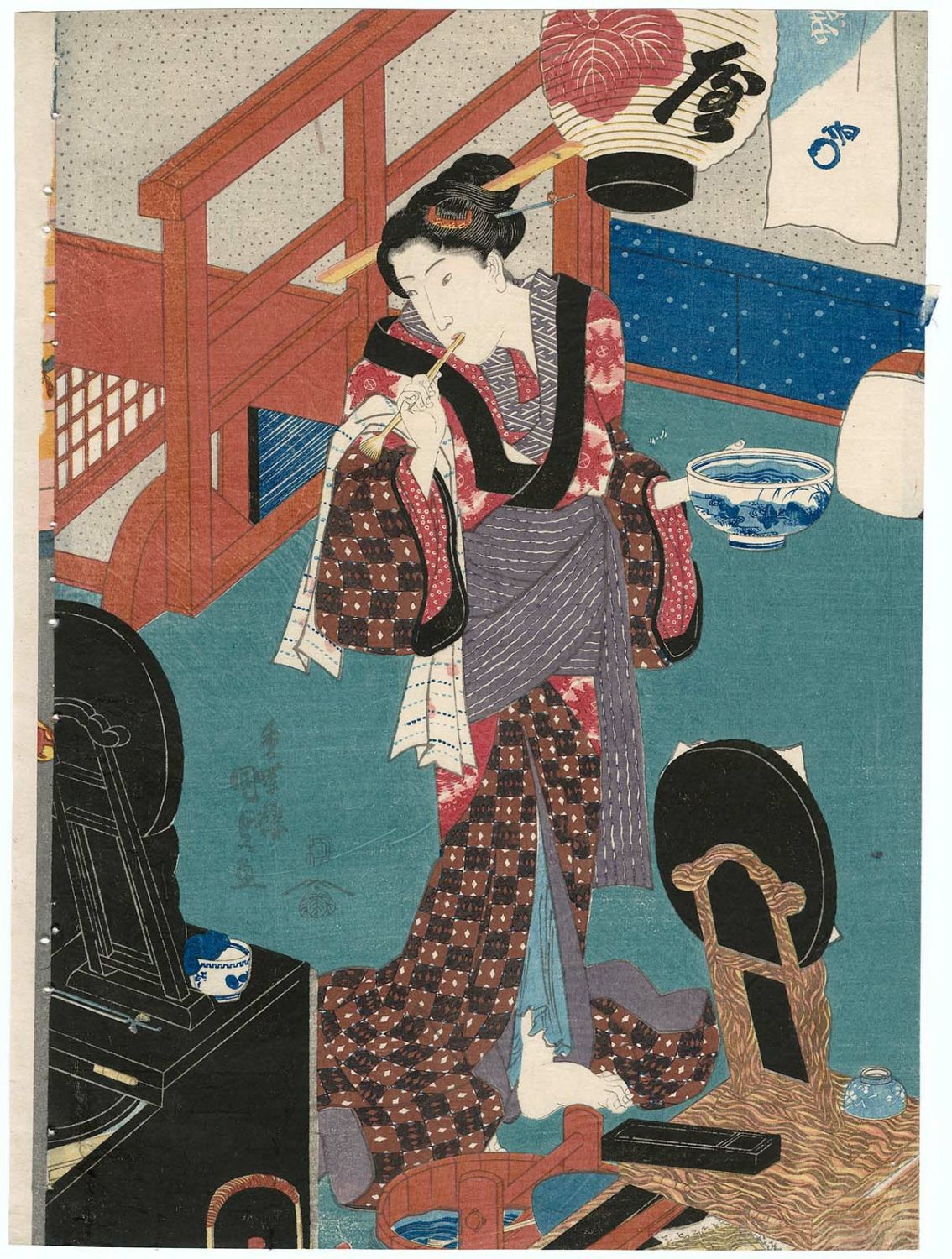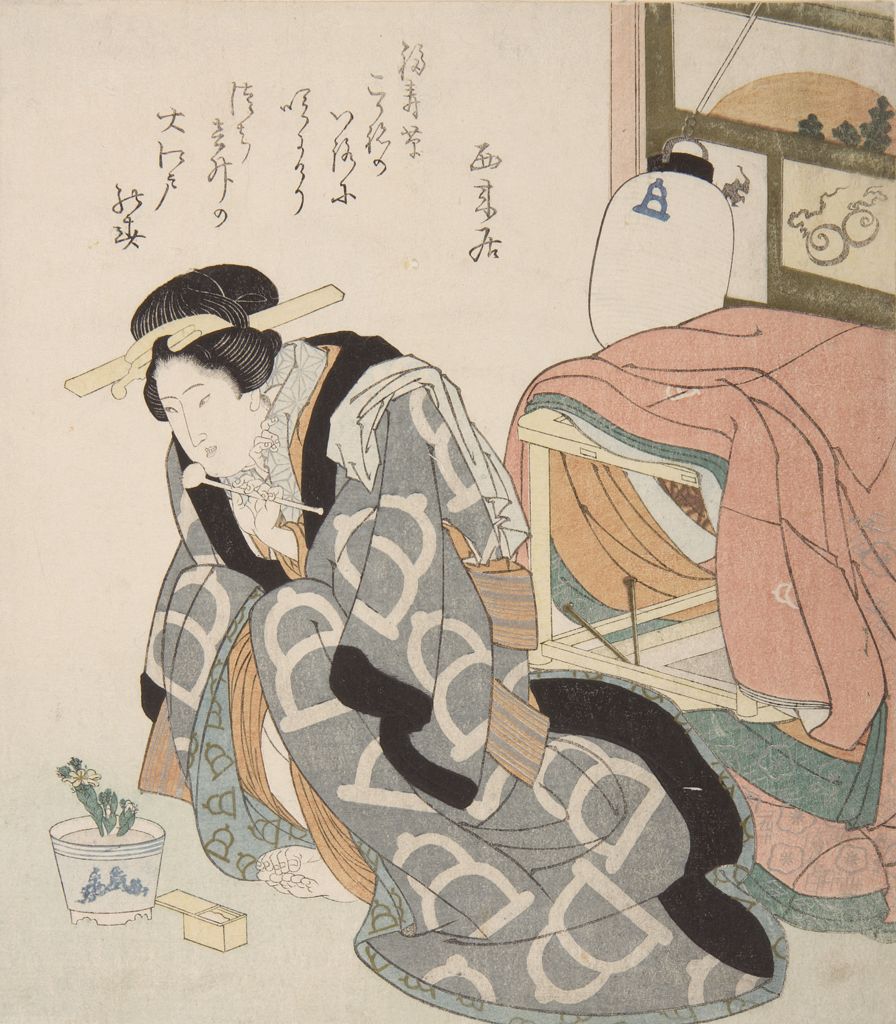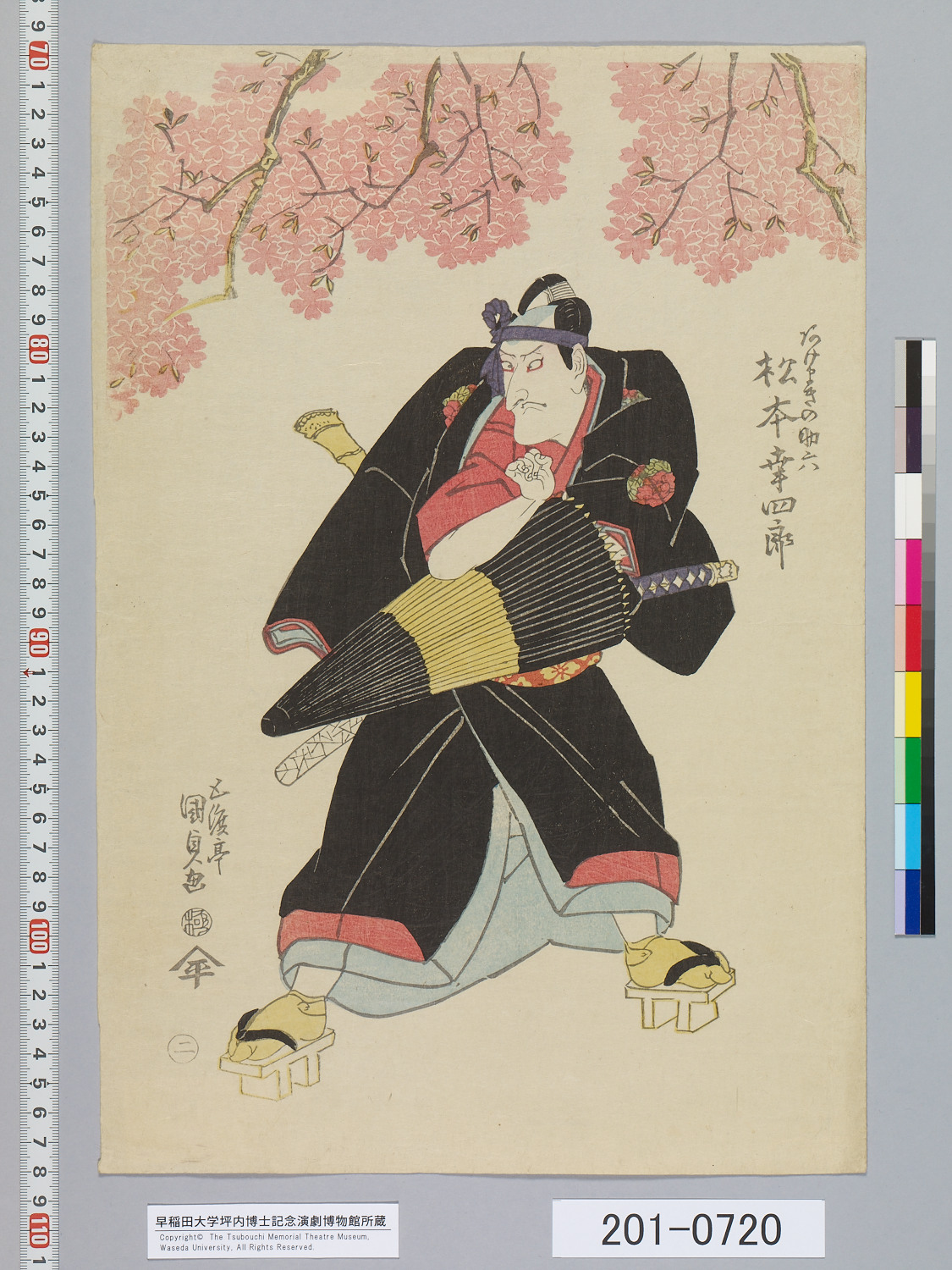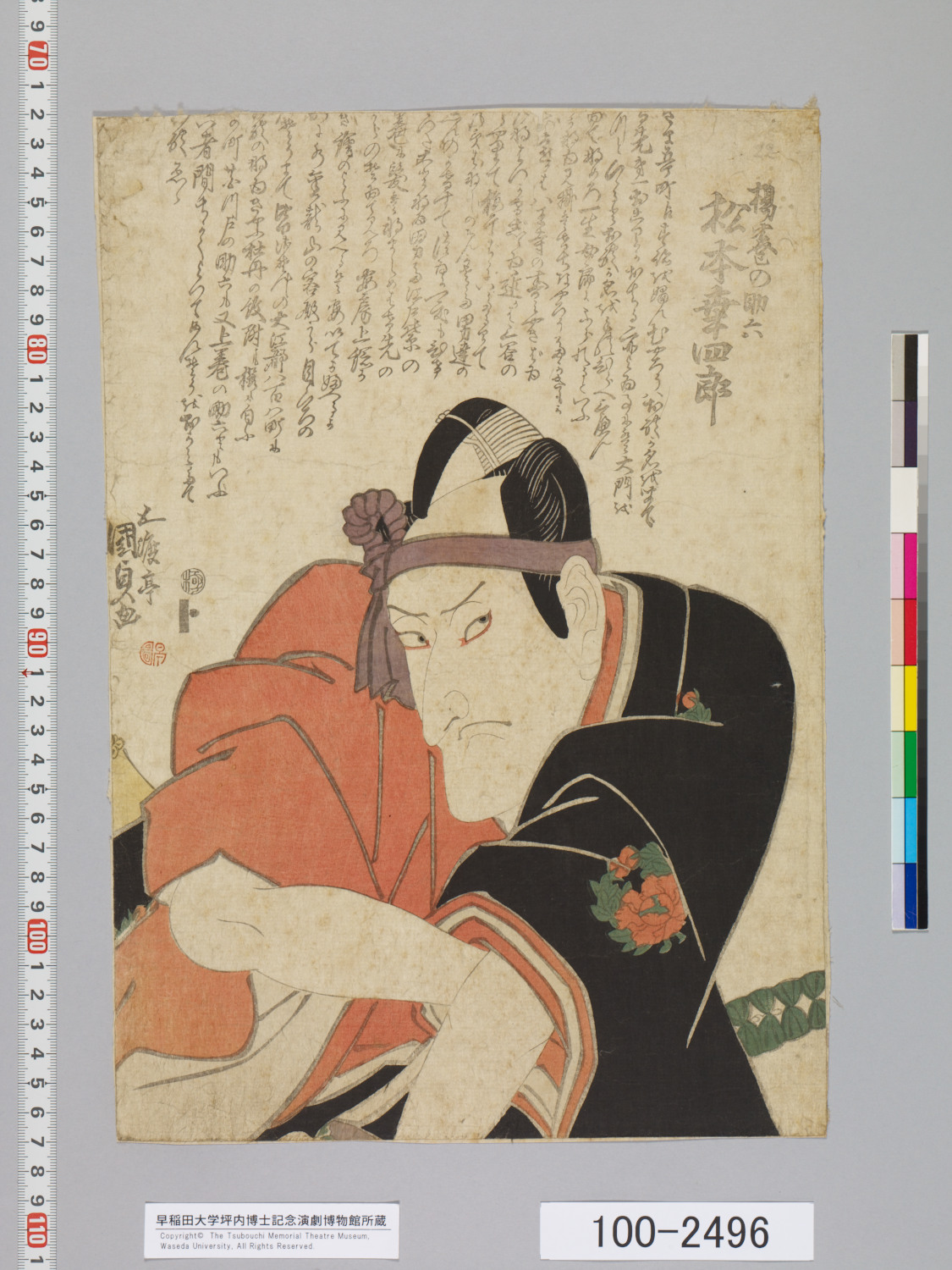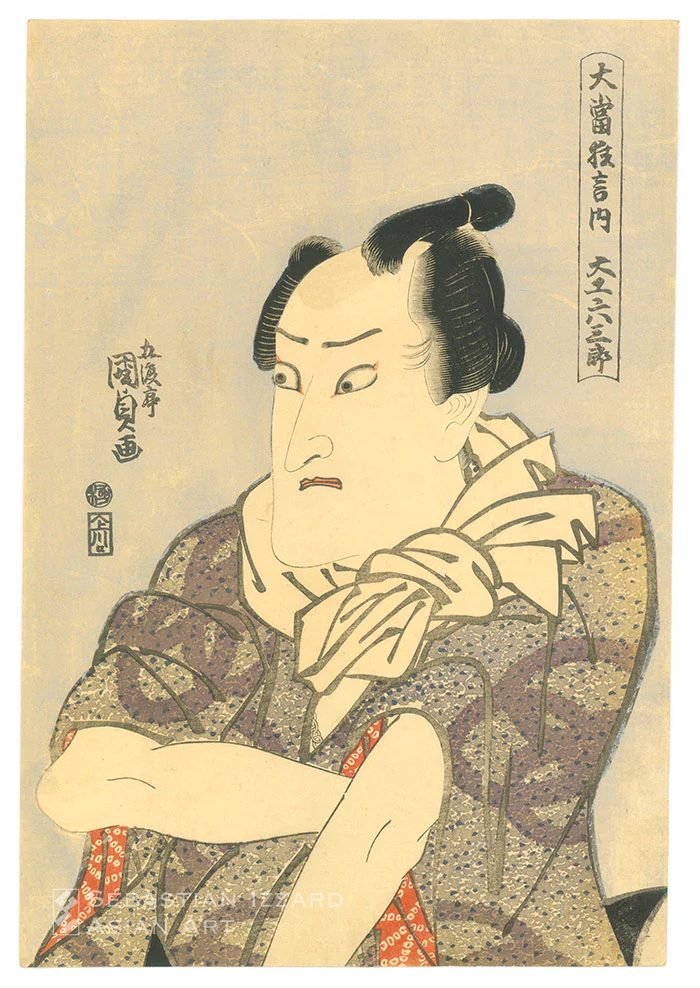-
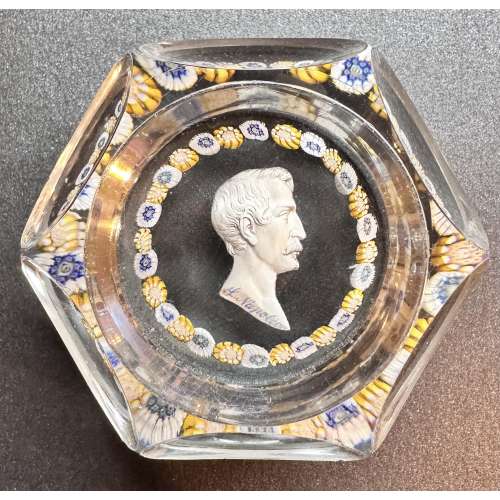 NEWTransparent colourless lead glass paperweight with sulphide portrait of Napoléon III undersigned 'L.Napoléon' in a millefiori circle. Character: Napoleon III, Charles-Louis Napoléon Bonaparte (French, 1808 – 1873) Maker: Compagnie des Cristalleries de Saint Louis, Saint-Louis-lès-Bitche, département Moselle, région Grand Est.
NEWTransparent colourless lead glass paperweight with sulphide portrait of Napoléon III undersigned 'L.Napoléon' in a millefiori circle. Character: Napoleon III, Charles-Louis Napoléon Bonaparte (French, 1808 – 1873) Maker: Compagnie des Cristalleries de Saint Louis, Saint-Louis-lès-Bitche, département Moselle, région Grand Est. -
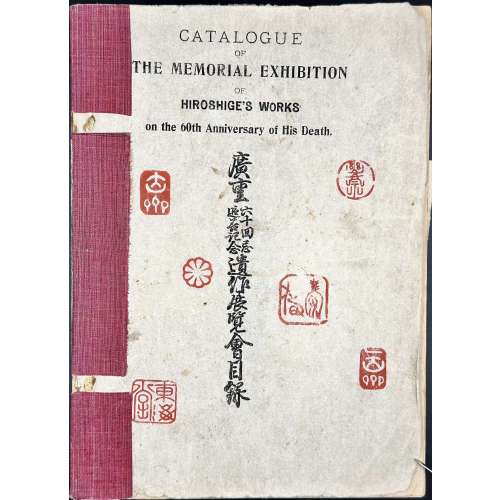 NEWPaperback volume with quarter red cloth backing 257 x 185 mm, black lettering in English and Japanese to front, red seals fac-simile to front and back; pp. [6] 1-6, 2-6 plates verso only, 7-26 [4] 1-66 [2] 7-88 plates verso only [2], some plates in colour with captioned tissue guards, incl. frontispiece memorial portrait of Utagawa Hiroshige [歌川 広重] a.k.a. Andō Hiroshige [安藤 広重] (Japanese, 1797 – 1858). Limited edition of 275 copies, this is copy № 254. Title-page: CATALOGUE | OF | THE MEMORIAL EXHIBITION | OF | HIROSHIGE'S WORKS | on the 60th Anniversary of His Death. | {red diamond} | Compiled and Published | BY | S. WATANABE. | (Ukiyoye Association) | TOKYO. | 1918. || Author: Shōzaburō Watanabe [渡辺 庄三郎] (Japanese, 1885 – 1962) Five fan prints: № 173. REFLECTED MOON ON THE SUMIDA. № 174. TOTO SHINAGAWA NO KEI. Shinagawa Beach, Yedo. № 179. ZUSÕ HAKONEYAMA YAKO NO ZU. Night Ascent of Hakone Pass. Published by Dansendo. № 180. TSUKI NO SANKEI. Beauties in a boat enjoying evening cool at Ryōgoku, from Three Moonlight Scenes. Published by Dansendo. № 182. SUMIDAGAWA HASHIBA WATASHI VUKI NO KEI. A Ferry Boat at a Sumida River Landing in Snow.
NEWPaperback volume with quarter red cloth backing 257 x 185 mm, black lettering in English and Japanese to front, red seals fac-simile to front and back; pp. [6] 1-6, 2-6 plates verso only, 7-26 [4] 1-66 [2] 7-88 plates verso only [2], some plates in colour with captioned tissue guards, incl. frontispiece memorial portrait of Utagawa Hiroshige [歌川 広重] a.k.a. Andō Hiroshige [安藤 広重] (Japanese, 1797 – 1858). Limited edition of 275 copies, this is copy № 254. Title-page: CATALOGUE | OF | THE MEMORIAL EXHIBITION | OF | HIROSHIGE'S WORKS | on the 60th Anniversary of His Death. | {red diamond} | Compiled and Published | BY | S. WATANABE. | (Ukiyoye Association) | TOKYO. | 1918. || Author: Shōzaburō Watanabe [渡辺 庄三郎] (Japanese, 1885 – 1962) Five fan prints: № 173. REFLECTED MOON ON THE SUMIDA. № 174. TOTO SHINAGAWA NO KEI. Shinagawa Beach, Yedo. № 179. ZUSÕ HAKONEYAMA YAKO NO ZU. Night Ascent of Hakone Pass. Published by Dansendo. № 180. TSUKI NO SANKEI. Beauties in a boat enjoying evening cool at Ryōgoku, from Three Moonlight Scenes. Published by Dansendo. № 182. SUMIDAGAWA HASHIBA WATASHI VUKI NO KEI. A Ferry Boat at a Sumida River Landing in Snow. -
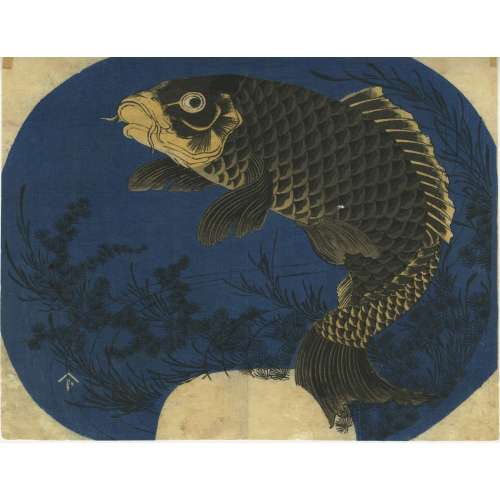 NEWAn uncut fan print depicting a carp (koi) swimming amid aquatic plants against a deep blue background. Artist: unknown/unsigned, possibly Katsushika Hokusai [葛飾 北斎] (Japanese, 1760 – 1849). Publisher: Enshūya Matabei [遠州屋又兵衛] (Japanese, fl. c. 1768 – 1881) Date: No date seal, no censor seal (privately printed?) Media: Fan print (uchiwa-e, 団扇絵), 224 x 290 mm. Similar subject:
NEWAn uncut fan print depicting a carp (koi) swimming amid aquatic plants against a deep blue background. Artist: unknown/unsigned, possibly Katsushika Hokusai [葛飾 北斎] (Japanese, 1760 – 1849). Publisher: Enshūya Matabei [遠州屋又兵衛] (Japanese, fl. c. 1768 – 1881) Date: No date seal, no censor seal (privately printed?) Media: Fan print (uchiwa-e, 団扇絵), 224 x 290 mm. Similar subject: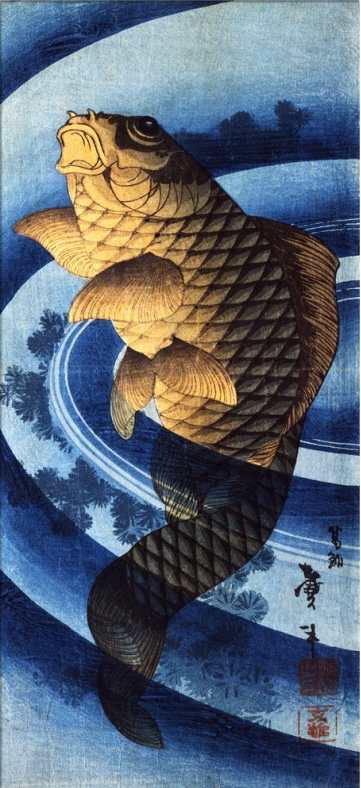
Katsushika TAITO II (fl. c. 1810-53)
-
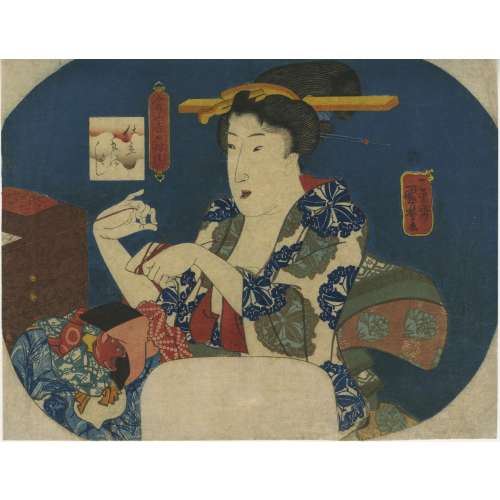 NEW
NEWA half-length portrait of a woman seated in an interior, winding red thread, dressed in a richly decorated kimono featuring intricate floral motifs in blue, green, and brown hues with a red underlayer. Her elaborately styled hair is adorned with a yellow comb and multiple hairpins. To her left is a partially visible wooden chest of drawers, to which a piece of red paper bearing calligraphy is affixed. A puppet or doll dressed in a patterned kimono with a striking red-painted face rests on her lap or a surface before her.
An uncut fan print (aiban yoko-e uchiwa-e) entitled “Good tailoring” or “Good sewing [仕立ものよし] (shitate monoyoshi)” from the series "It’s an Auspicious Day to…" [最上吉日つくし] (Saijō [no] kichijitsu tsukushi).
Artist: Utagawa Kuniyoshi [歌川 國芳] (Japanese, 1798 – 1861).
Signature: Ichiyûsai Kuniyoshi giga (一勇斎 國芳戯画, playfully drawn by Ichiyûsai Kuniyoshi).
Publisher: Enshūya Matabei [遠州屋又兵衛] (Enterprise, active c. 1768 – 1881); seal: "to" (ト) under roof (Marks 01-031 | 057a). Nanushi seal Watari (渡) for Watanabe Shōemon, VI/1842-V 1c/1846. Media: Fan print (uchiwa-e, 団扇絵), 224 x 290 mm. Reference: (1) Kuniyoshi project; (2) Tokyo Museum Digital Archive [Thanks to Horst Greabner] -
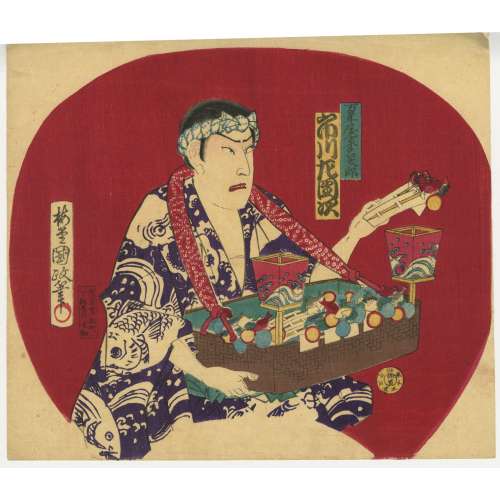 NEW
NEWTitle: Kabuki Actor Ichikawa Sadanji I as Mannenya Kamei Tarō
Artist: Utagawa Kunisada III (Baido Kunimasa) [Japanese, 1848–1920]
Signature: Baidō Kunimasa hitsu (梅堂國政筆)
Actor: Ichikawa Sadanji I (市川左団次, also known as Ichikawa Shōjaku I, Ichikawa Koyone, Ichikawa Tatsuzō) [Japanese, 1842–1904]
Role: Mannenya Kamei Tarō (万年屋家名太郎)
Play: Unidentified
Publisher: Shimōsaya Masukichi (下総屋升吉)
Publisher’s Address: Asakusa, Kurofune-chō (浅草 黒舩)
Date: Meiji 30 (1897), 3rd month
Medium: Uchiwa-e (団扇絵, fan print), ink and colour on paper, 245 × 282 mmThis uchiwa-e (fan print) by Utagawa Kunisada III (also known as Utagawa Kunimasa IV) portrays the kabuki actor Ichikawa Sadanji I in the role of Mannenya Kamei Tarō. The figure is depicted in a dramatic stance, dressed in a striking blue kimono adorned with fish and wave motifs, suggesting a maritime or festival connection. He carries a large basket supported by a fabric strap around his neck, filled with small toy fish attached to sticks, along with round objects that could be festival sweets or miniature decorations. In his right hand, he holds one of these toy fish-on-a-stick items, possibly demonstrating it as part of a vendor's performance.
The background is a bold deep red, contrasting with the detailed rendering of the actor’s expression and costume. The print was published in 1897 (Meiji 30) by Shimōsaya Masukichi, a publisher based in Asakusa, Kurofune-chō. Though the exact play remains unidentified, the composition captures a moment from a kabuki performance where street vendors and festival sellers were often featured as comic or supporting characters in Edo-period narratives.
This work exemplifies the continuation of traditional kabuki actor portraiture into the Meiji period, reflecting both theatrical culture and popular printmaking traditions at the time.
-
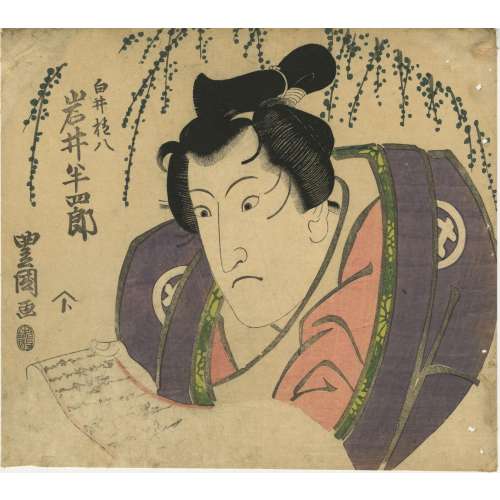 NEWKabuki actor Iwai Hanshiro V, in the role of Shirai Gonpachi, stands under a willow tree (yanagi, 柳) to read a letter from the courtesan Komurasaki of the Miuraya [三浦屋小紫]. In this letter, Komurasaki laments their unfortunate love. This is a scene from the kabuki play The Floating World's Pattern and Matching Lightning Bolts (Ukiyozuka hiyoku no inazuma) [浮世柄比翼稲妻] written by Tsurya Namboku IV [鶴屋南北]; it was played for the first time in March 1823 at Ichimura Theatre [市村座] in Edo. This play was later divided into two individual pieces: Saya-ate [鞘当] and Fuwa [不破]. On the shoulders of the actor's garment is a character 井 in a circle — both names, Iwai 岩井 and Shirai 白井, use this character.
NEWKabuki actor Iwai Hanshiro V, in the role of Shirai Gonpachi, stands under a willow tree (yanagi, 柳) to read a letter from the courtesan Komurasaki of the Miuraya [三浦屋小紫]. In this letter, Komurasaki laments their unfortunate love. This is a scene from the kabuki play The Floating World's Pattern and Matching Lightning Bolts (Ukiyozuka hiyoku no inazuma) [浮世柄比翼稲妻] written by Tsurya Namboku IV [鶴屋南北]; it was played for the first time in March 1823 at Ichimura Theatre [市村座] in Edo. This play was later divided into two individual pieces: Saya-ate [鞘当] and Fuwa [不破]. On the shoulders of the actor's garment is a character 井 in a circle — both names, Iwai 岩井 and Shirai 白井, use this character.
More information about the play and the real story behind it can be found at Lyon Collection. Actor: Iwai Hanshirō V [岩井半四郎] (Japanese, 1776 – 1847); other names: Iwai Tojaku, Iwai Kumesaburō I. Role: Shirai Gonpachi [白井権八] Artist: Utagawa Toyokuni I [歌川豊国] (1769–1825). Signed: Toyokuni ga [豊国画]. Publisher: Enshūya Matabei [遠州屋又兵衛] (Enterprise, active c. 1768 – 1881); seal: “to” (ト) under roof (Marks 01-031 | 057a). Date-aratame censor seal: 未改, Bunsei 6 (1823). Media: Aiban yoko-e uchiwa-e 団扇絵), 233 x 260 mm."Ukiyozuka Hiyoku no Inazuma" is a kabuki play in nine acts, written by Tsuruya Nanboku IV. It premiered in Bunsei 6 (1823) at the Ichimura-za theatre in Edo.
The play includes two particularly famous scenes:
- "Suzugamori no ba" (The Scene at Suzugamori), which portrays the episode of Banzuiin Chōbei and Shirai Gonpachi
- "Yoshiwara Nakanochō no ba" (The Scene at Yoshiwara Nakanochō), which depicts the story of Nagoya Sanza and Fuwa Banzaemon
These scenes have been frequently performed under the well-known titles "Gozonji Suzugamori" (A Well-Known Suzugamori) and "Sayaate" (The Scabbard Clash).
-
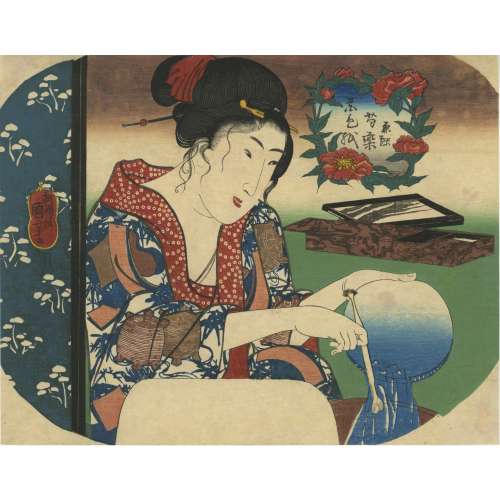 NEWPeonies (Shakuyaku) [芍薬] Series: Flower-Colored Papers (Hana Shikishi) [花色紙] Artist: Utagawa Kuniyoshi [歌川 國芳] (Japanese, 1798–1861) Signature: Chō-ō-rō Kuniyoshi ga (朝櫻楼 國芳 画) Publisher: Kojimaya Jūbei [小島屋 十兵衛] (Japanese, 1797 – 1869); seal 十, Marks 06-014 | 264a Date/Censorship Approval: Nanushi seal Yoshimura (吉村) for Yoshimura Gentarō (吉村 源太郎), VI/1843–XI/1846. Medium: Rigid fan print (Aiban Yoko-e Uchiwa-e, 合判横絵 団扇絵), 222 x 284 mm.
NEWPeonies (Shakuyaku) [芍薬] Series: Flower-Colored Papers (Hana Shikishi) [花色紙] Artist: Utagawa Kuniyoshi [歌川 國芳] (Japanese, 1798–1861) Signature: Chō-ō-rō Kuniyoshi ga (朝櫻楼 國芳 画) Publisher: Kojimaya Jūbei [小島屋 十兵衛] (Japanese, 1797 – 1869); seal 十, Marks 06-014 | 264a Date/Censorship Approval: Nanushi seal Yoshimura (吉村) for Yoshimura Gentarō (吉村 源太郎), VI/1843–XI/1846. Medium: Rigid fan print (Aiban Yoko-e Uchiwa-e, 合判横絵 団扇絵), 222 x 284 mm.Interpretation of the Inscription in the Floral Cartouche
- 花色紙 (Hana Shikishi) – "Flower-Colored Paper" or "Decorative Shikishi Paper with Floral Motifs"
- 芍薬 (Shakuyaku) – "Peony", a flower symbolizing prosperity, beauty, and romance in Japanese culture
- 団扇絵 (Uchiwa-e) – "Round Fan Illustration" or "Picture on an Uchiwa (rigid fan)"
Description & Symbolic Analysis
This print, part of the Hana Shikishi (Flower-Colored Papers) series, depicts a woman washing a basin after brushing her teeth. She is positioned behind an indigo-colored folding screen, adorned with a repeating pattern of distant pines, presented in reverse printing technique (wyabori, 捺ぼり). The screen is a visual separator, adding depth and an intimate atmosphere to the scene. The woman is portrayed in a three-quarter view, facing left, her face delicately contoured. She is dressed in a safflower-dyed kimono (furisode, 振袖) featuring an asanoha (麻の葉, hemp leaf) shibori pattern, a motif often associated with purity and protection. Over this, she wears an outer garment decorated with an indigo bamboo motif, symbolizing strength and resilience. Additionally, the garment features:- Double gourd (瓢箪, hyōtan) symbolises longevity, fertility, and good fortune.
- Strips of paper resembling “next-morning letters” (kinuginu no fumi, 衣衣の文) – These evoke romantic correspondence or the written wishes of the Tanabata festival.
- Spools or reels of thread (chikiri, 糸巻き) – A motif reminiscent of Tanabata festival themes, often linked to the celestial lovers Orihime and Hikoboshi. The phonetic pun with chigiri (契り, vow or romantic promise) reinforces themes of marriage, fate, and lifelong bonds.
Adornment & Hairstyling
Her elaborate hairstyle features a red hair tie (musubi, 結び), signifying youth and romantic allure. It is further adorned with:- Golden kogai (笄) – A decorative hairpin, often used by courtesans or high-ranking women.
- Tama kanzashi (玉簪) – A ball-tipped ornamental hairpin, reinforcing her refined status.
Objects in the Scene & Their Symbolism
The woman is holding a traditional Japanese toothbrush (fusa-yōji, ふさ楊枝) in her right hand, while pouring out water from the basin after brushing her teeth. This act symbolizes purity and preparation for intimacy. To her right, an ornate lacquered writing box (suzuribako, 硯箱) is placed near an inkstone (硯, suzuri). This object could also be interpreted as a dreamstone (梦石, mèng shí), a scholar’s object associated with nostalgia, love, or secret communication.Context in Ukiyo-e Tradition
Tooth brushing was uncommon in bijin-ga (美人画, "beautiful woman prints"). Ukiyo-e frequently depicted women engaging in personal grooming rituals, reflecting ideals of elegance and self-care in Edo-period culture.
Two additional fan prints from the Hana Shikishi series have been identified and can be found at the Kuniyoshi Project website:- Morning Glory (Asagao, 朝顔)
- Clematis (Tessen, 鉄線)
These prints, like Peonies (Shakuyaku), emphasize seasonal beauty and feminine refinement, themes central to Kuniyoshi’s bijin-ga oeuvre.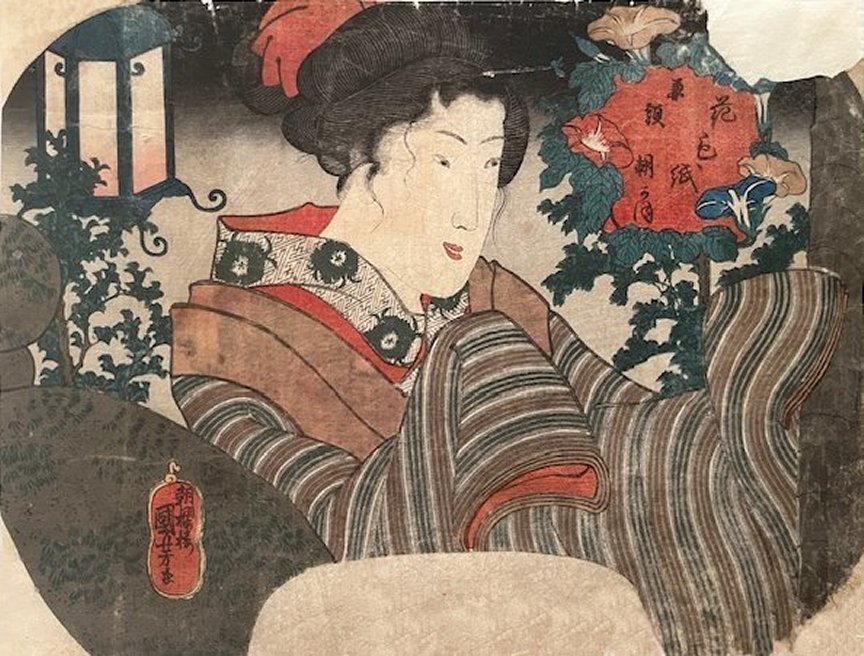
Morning Glory (Asagao, 朝顔)
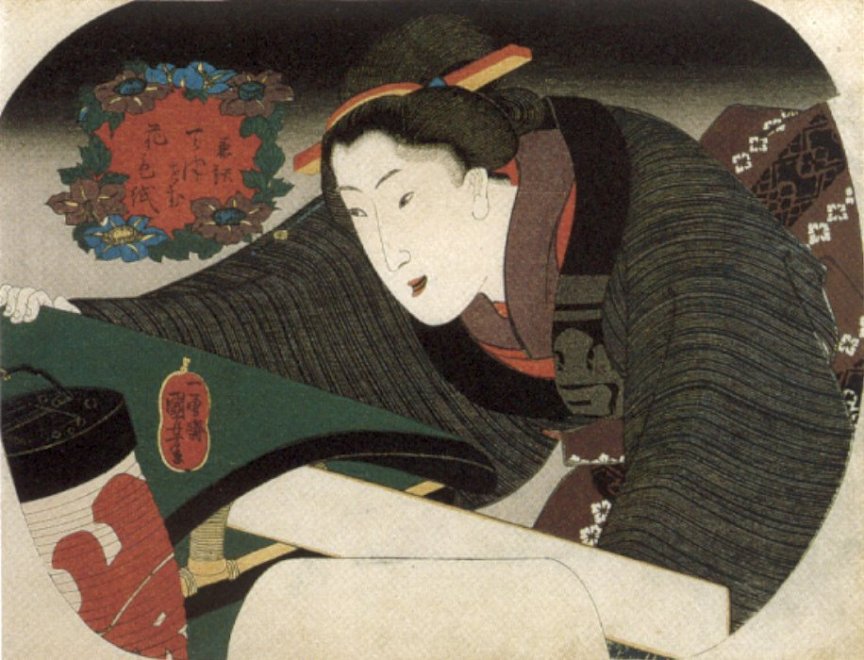
Clematis (Tessen, 鉄線)
-
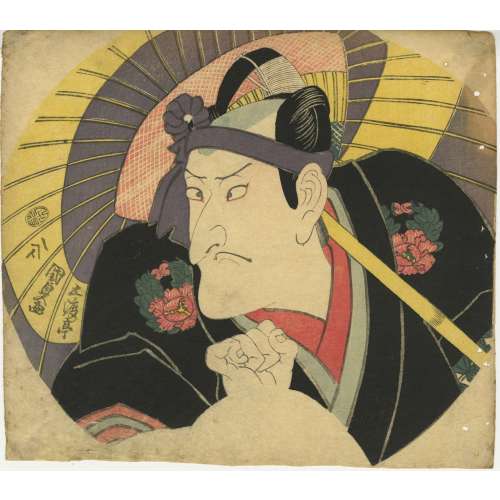 NEW
NEWArtist: Utagawa Kunisada [歌川 国貴] a.k.a. Utagawa Toyokuni III [三代歌川豐国] (Japanese, 1786–1865)
Publisher: unknown (Ichi-To, 未詳); Marks 05-012 | U085a; seal (一、ト). Date-aratame seal: Bunsei 5 (文政五年, 1822). Media: Fan print (Aiban yoko-e uchiwa-e, 合別横絵団扇絵); 234 × 264 mm. Actor: Matsumoto Kōshirō V [五代相本幸四郎] (Japanese, 1764–1838); other names: Ichikawa Komazō III [市川高麻蔵], Ichikawa Sumizō I [市川寿美蔵]. Role: Hanakawado no Sukeroku [花川戸の助六]. Play: Sukeroku sakura no futae obi [助六桜の二重帯].This bust-length portrait depicts kabuki actor Matsumoto Kōshirō V in the role of Hanakawado no Sukeroku under a vast umbrella, in a three-quarter view, facing right, with his fist firmly clenched, and with an expression of intensity and determination. His protuberant nose is accentuated, a defining feature of Matsumoto Kōshirō V. The actor wears a black outer robe adorned with stylized peonies (牡丹, botan), a floral motif symbolizing strength, nobility, and elegance—qualities that define both the Sukeroku character and Kōshirō V’s acting style. The print belongs to the yakusha-e (役者絵, "actor print") genre, celebrating kabuki stars of the Edo period. The artist's signature, publisher’s seal, and censor’s seal are written on the umbrella. Play Sukeroku sakura no futae obi was staged in March 1822 (Bunsei 5) at Kawarazaki Theater (歌川戸室) in Edo (Tokyo). In this version of the Sukeroku narrative, the protagonist is revealed to be Jirō Suketoshi of Kyoto [京の次郎祐俊], a nobleman in disguise. Like other Sukeroku adaptations, the story centres on themes of chivalry, revenge, and romantic rivalry in Edo’s pleasure quarters. Another Kunisada's portraits of Matsumoto Kōshirō V as Sukeroku, in Ōban format:
The History of Sukeroku in Kabuki Theater
The play Sukeroku (English title Sukeroku: Flower of Edo), originally titled Hana Yakata Aigo Zakura (花館愛護櫻), premiered in the 3rd lunar month of 1713 at Yamamuraza in Edo. The script was written by Tsuuchi Han'emon (津打半右衛門) under the guidance of Tsuuchi Jihē II (津打治兵衛, 1679–1760). The inaugural performance featured Ichikawa Danjūrō II as Sukeroku, Tamazawa Rin'ya as Agemaki, Ikushima Shingorô as the shirozake seller (白酒売り) Shinbē, and Yamanaka Heikurô I as Ikyū. Three years later, in 1716, Tsuuchi Jihē II revised the play, integrating it into the well-known Soga brothers' revenge tale. In this adaptation, Sukeroku, Agemaki, and Shinbē were revealed to be Soga Gorō Tokimune, the courtesan Kewaizaka no Shōshō, and Soga Jūrō Sukenari, respectively. This revised version was staged at Nakamuraza in the 2nd lunar month of 1716, with Ichikawa Danjūrō II reprising the role of Sukeroku, joined by Nakamura Takesaburô I (Agemaki), Mimasuya Sukejûrô I (Shinbē), Sodeoka Masanosuke II (Soga’s mother Mankō), and Ôtani Hiroemon I (Ikyū). Over time, Sukeroku became closely associated with the Ichikawa Danjūrō acting lineage, captivating Edo audiences and securing its place in the kabuki repertoire. Though traditionally performed by members of the Naritaya guild, the role of Sukeroku was occasionally played by actors from outside the Ichikawa family. The play was later staged under the title Sukeroku Yukari no Edo Zakura for the first time in the 4th lunar month of 1782 at Ichimuraza, with Ichimura Uzaemon IX portraying the titular role. Comparison to Toyokuni I’s 1816 Print Kunisada’s portrait can be viewed as a homage to his mentor, Utagawa Toyokuni I [初代歌川豊国] (1769–1825), whose earlier 1816 bust-length portrait of Iwai Hanshirō V [岩井半四郎] as Sukeroku (published by Ibaya Senzaburō [伊場屋仙三郎]) shares a similar composition and dramatic pose. While Matsumoto Kōshirō V’s portrayal (Kunisada, 1822) emphasizes power and masculinity through the peony motif, Iwai Hanshirō V’s 1816 version (Toyokuni I) reflects grace and refinement, featuring a kimono adorned with irises (菖蒲, shōbu)—a flower symbolizing purity and elegance. Additionally, the word shōbu (iris) is a homophone for 尚武, meaning "martial spirit", subtly reinforcing Sukeroku’s strength beneath his stylish exterior. These contrasts highlight the differences in kabuki acting styles—with Kōshirō V specializing in strong, heroic roles and Hanshirō V excelling in onnagata (female-role) performances. -
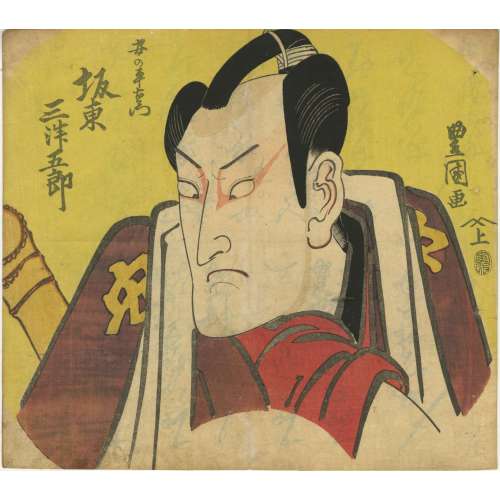 NEW
NEWArtist: Utagawa Toyokuni I [初代豊国] (Japanese, 1769–1825)
Publisher: Iseya Sōemon [伊勢屋惣右衛門] (c. 1776 – November 1862); Marks 02-041 | 156a
Date-Aratame Seal: Bunsei 1 (文政元年, 1818)
Media: Print (Yakusha-e, 役者絵); 223 x 250 mm
Actor: Bandō Mitsugorō III [三代目 坂東 三津五郎] (Japanese, 1775–1831); also known as Bandō Minosuke I, Morita Kanjirō II, Bandō Mitahachi I, Bandō Minosuke I, Bandō Mitahachi I.
Role: Anno Heiemon [安の平右衛門], also known as Anno Heibei [安の平兵衛].
Play: Shiire Zome Karigane Gomon [仕入染雁金五紋] (しいれぞめかりがねごもん), staged in May 1818 at Nakamuraza Theatre in Edo (modern-day Tokyo).
Bust-length, three-quarter-view portrait of actor Bandō Mitsugorō III as Anno Heibei, one of the gonin otoko [五人男]—a group of five chivalrous thieves. The actor is dressed in a red and purple robe, with a golden mon (family crest) on the shoulders, displaying the character 安 (An), which, in this case, represents the first ideogram in the name of his role. A shakuhachi (尺八), a traditional Japanese end-blown bamboo flute, is secured on his back.
-
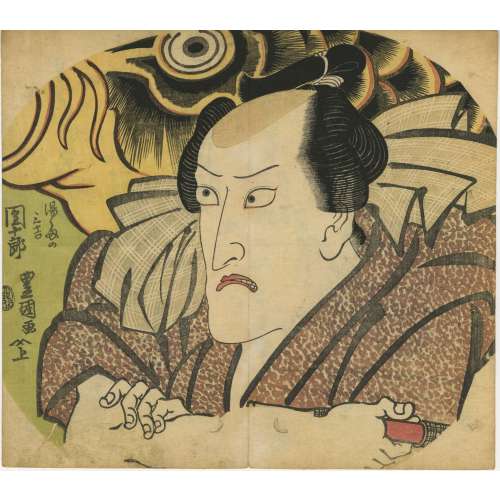 NEWArtist: Utagawa Toyokuni I [初代豊国] (Japanese, 1769–1825) Signed: Toyokuni ga [豊国画]. Publisher: Iseya Sōemon [伊勢屋惣右衛門] (c. 1776 – November 1862); Marks 02-041 | 156a Date-Aratame Seal: 1819 (Bunsei 2, 文政二年) Media: Print (Yakusha-e, 役者絵); 221 x 253 mm
NEWArtist: Utagawa Toyokuni I [初代豊国] (Japanese, 1769–1825) Signed: Toyokuni ga [豊国画]. Publisher: Iseya Sōemon [伊勢屋惣右衛門] (c. 1776 – November 1862); Marks 02-041 | 156a Date-Aratame Seal: 1819 (Bunsei 2, 文政二年) Media: Print (Yakusha-e, 役者絵); 221 x 253 mmActor: Ichikawa Danjūrō VII [七代目市川團十郎] (Japanese, 1791–1859); Other names: Ichikawa Ebizō V (五代目市川海老蔵), Ichikawa Hakuen II (二代目市川白猿), Ichikawa Shinnosuke I (初代市川新之助).
Role: Yushima no Sankichi (ゆしまの三吉) Play: Ume Yanagi Wakaba no Kagazome (梅柳若葉加賀染) Theater: Tamagawa-za (玉川座), Edo, May 1819 Bust-length, three-quarter-view portrait of Ichikawa Danjūrō VII as Yushima no Sankichi, in the play Ume Yanagi Wakaba no Kagazome, staged at Tamagawa-za in May 1819. The actor is depicted with his arms crossed over his chest, holding a pipe (kiseru, 煙管) in his right hand. The upper half of the background features a giant golden carp (鯉, koi), symbolizing Boys' Day (Tango no Sekku) (端午の節句), celebrated on May 5th each year. This print forms a pair with the portrait of Kabuki actor Segawa Kikunojō V as Kurenaiya Okan [SVJP-0440.2025], but no conclusive information is available regarding the relationship between their characters.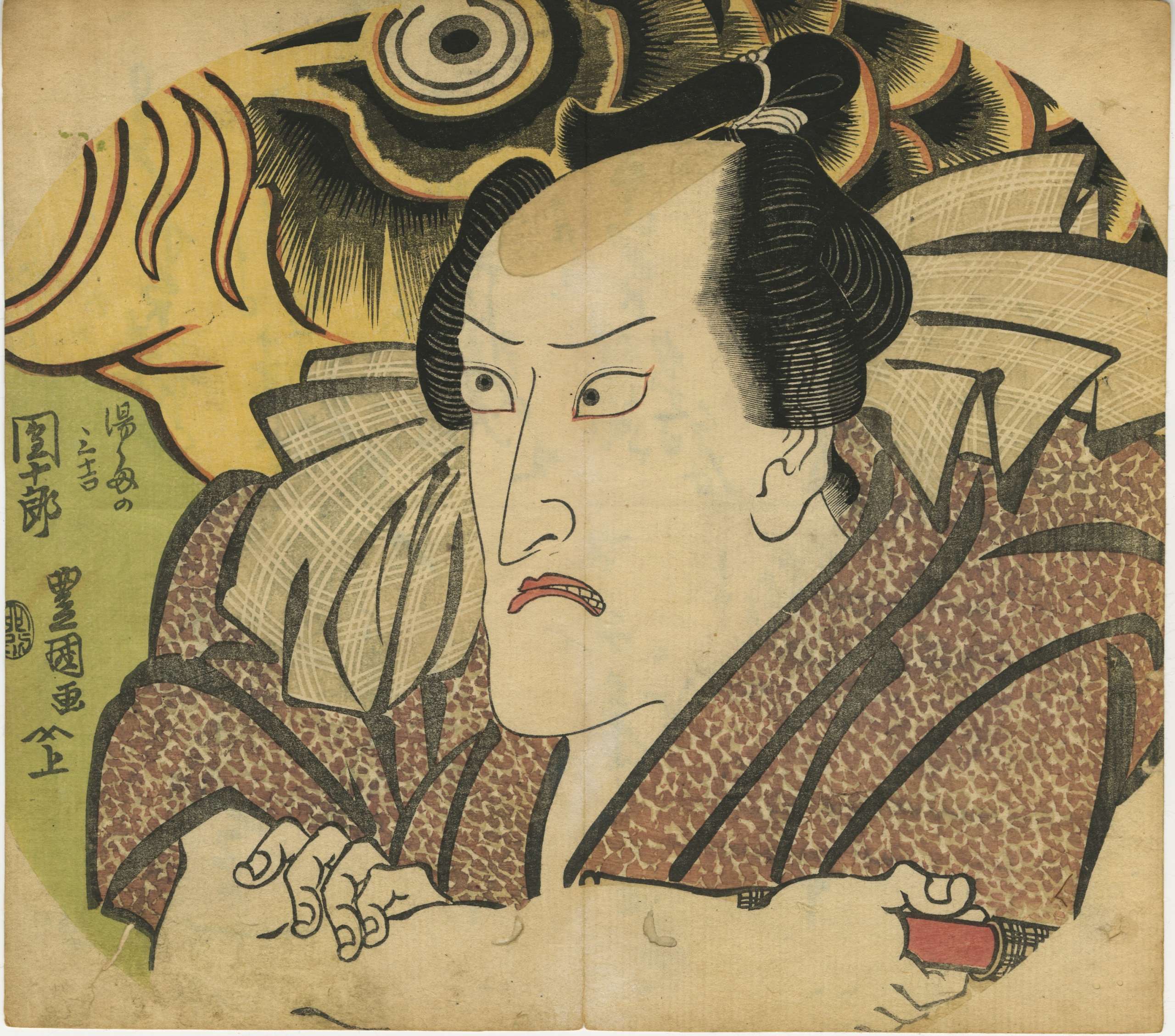
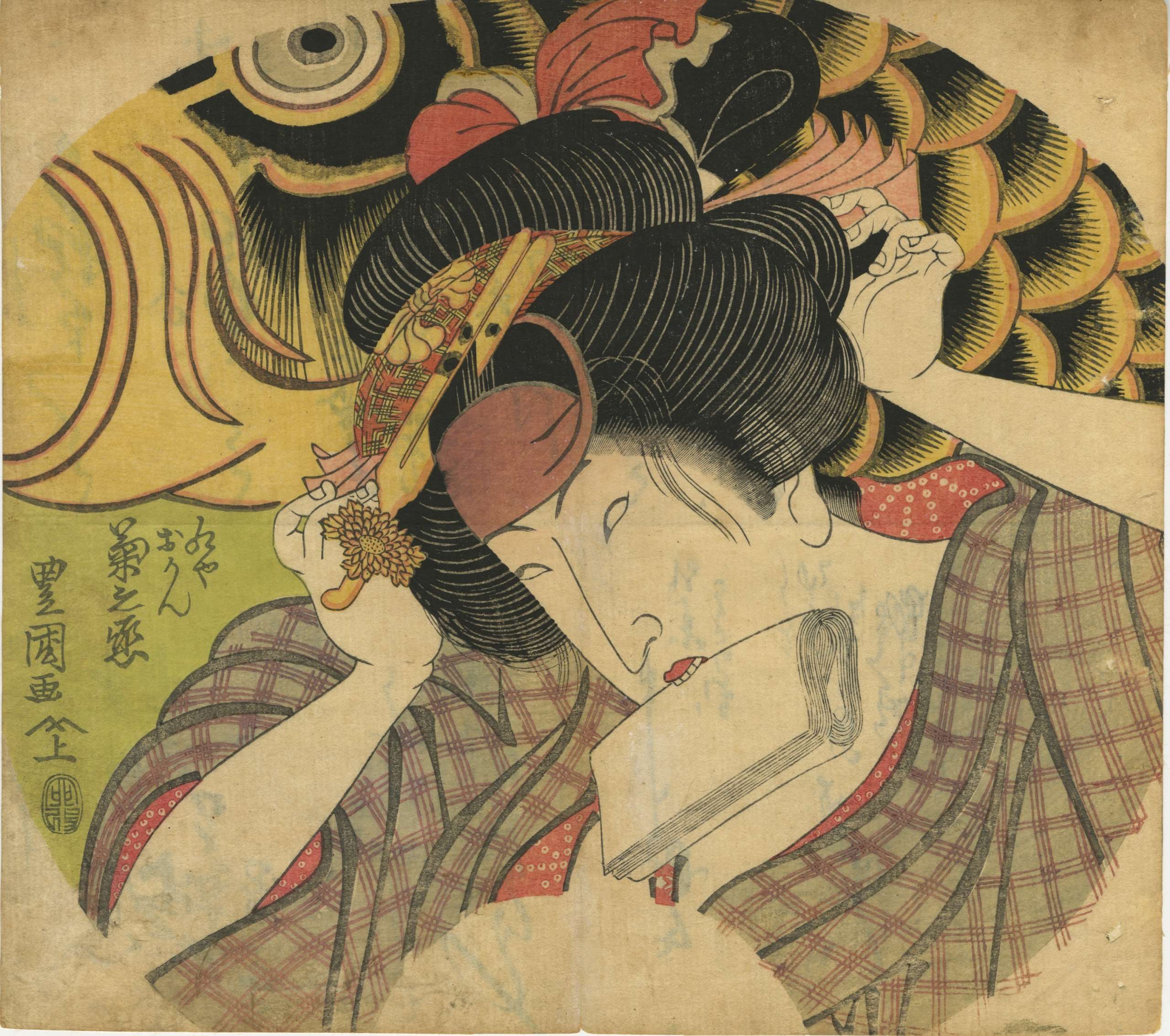
-
 NEWArtist: Utagawa Toyokuni I [初代豊国] (Japanese, 1769–1825) Signed: Toyokuni ga [豊国画]. Publisher: Iseya Sōemon [伊勢屋惣右衛門] (c. 1776 – November 1862); Marks 02-041 | 156a Date-Aratame Seal: 1819 (Bunsei 2, 文政二年) Media: Print (Yakusha-e, 役者絵); 221 × 253 mm Play: Ume Yanagi Wakaba no Kagazome (梅柳若葉加賀染) Theater: Tamagawa-za (玉川座), Edo, May 1819 Role: Kurenaiya Okan (紅屋おかん) Actor: Segawa Kikunojō V [瀬川菊之丞] (Japanese, 1802–1832); Other name: Segawa Tamon I (瀬川多聞初代) Bust-length, three-quarter-view portrait of Segawa Kikunojō V as Kurenaiya Okan in the play Ume Yanagi Wakaba no Kagazome, staged at Tamagawa-za in May 1819. The male actor Segawa Kikunojō V performs an onnagata role, portraying a courtesan. She is depicted adjusting her elaborate shimadamage-style coiffure, fixing a kanzashi (簪, hairpin) while holding onkotogami (御懲紙, tissue paper) in her mouth. The onkotogami was traditionally used for intimate hygiene, suggesting that the scene represents a moment after encountering a client. Her inner kimono is safflower-dyed and has a hemp leaf pattern (麻の葉, asa no ha). The top half of the background features a giant golden carp (鯉, koi), a recurring motif in this pair of prints often associated with strength, perseverance, and kabuki’s aragoto style. This print forms a pair with the portrait of Ichikawa Danjūrō VII as Yushima no Sankichi [SVJP-0439.2025], but no conclusive information is available regarding the relationship between their characters. The carp also alludes to Boys' Day (Tango no Sekku, 端午の節句), celebrated on May 5th each year.
NEWArtist: Utagawa Toyokuni I [初代豊国] (Japanese, 1769–1825) Signed: Toyokuni ga [豊国画]. Publisher: Iseya Sōemon [伊勢屋惣右衛門] (c. 1776 – November 1862); Marks 02-041 | 156a Date-Aratame Seal: 1819 (Bunsei 2, 文政二年) Media: Print (Yakusha-e, 役者絵); 221 × 253 mm Play: Ume Yanagi Wakaba no Kagazome (梅柳若葉加賀染) Theater: Tamagawa-za (玉川座), Edo, May 1819 Role: Kurenaiya Okan (紅屋おかん) Actor: Segawa Kikunojō V [瀬川菊之丞] (Japanese, 1802–1832); Other name: Segawa Tamon I (瀬川多聞初代) Bust-length, three-quarter-view portrait of Segawa Kikunojō V as Kurenaiya Okan in the play Ume Yanagi Wakaba no Kagazome, staged at Tamagawa-za in May 1819. The male actor Segawa Kikunojō V performs an onnagata role, portraying a courtesan. She is depicted adjusting her elaborate shimadamage-style coiffure, fixing a kanzashi (簪, hairpin) while holding onkotogami (御懲紙, tissue paper) in her mouth. The onkotogami was traditionally used for intimate hygiene, suggesting that the scene represents a moment after encountering a client. Her inner kimono is safflower-dyed and has a hemp leaf pattern (麻の葉, asa no ha). The top half of the background features a giant golden carp (鯉, koi), a recurring motif in this pair of prints often associated with strength, perseverance, and kabuki’s aragoto style. This print forms a pair with the portrait of Ichikawa Danjūrō VII as Yushima no Sankichi [SVJP-0439.2025], but no conclusive information is available regarding the relationship between their characters. The carp also alludes to Boys' Day (Tango no Sekku, 端午の節句), celebrated on May 5th each year.

-
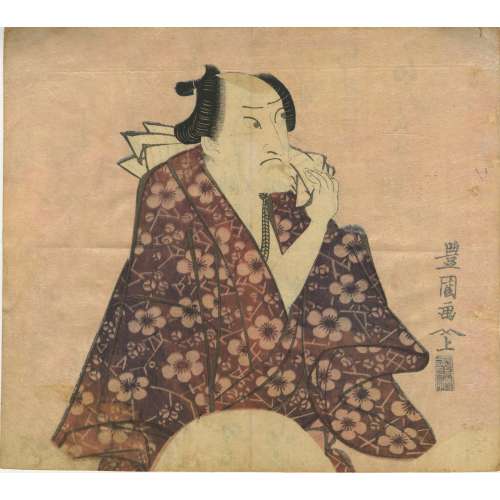 NEWArtist: Utagawa Toyokuni I [初代豊国] (Japanese, 1769–1825) Signed: Toyokuni ga [豊国画] Publisher: Iseya Sōemon [伊勢屋惣右衛門] (c. 1776 – November 1862); Marks 02-041 | 156a Date-Aratame Seal: 1815 (Bunka 12, 文化十二年) Media: Print (Uchiwa-e, うちわ絵, fan print), kira-zuri (きら摺り, mica printing); 222 × 250 mm
NEWArtist: Utagawa Toyokuni I [初代豊国] (Japanese, 1769–1825) Signed: Toyokuni ga [豊国画] Publisher: Iseya Sōemon [伊勢屋惣右衛門] (c. 1776 – November 1862); Marks 02-041 | 156a Date-Aratame Seal: 1815 (Bunka 12, 文化十二年) Media: Print (Uchiwa-e, うちわ絵, fan print), kira-zuri (きら摺り, mica printing); 222 × 250 mmActor: Onoe Baikō III [三代目尾上梅幸] (Japanese, 1784–1849); Other names: Onoe Kikugorō III (尾上菊五郎), Ōkawa Hashizō I (大川橋蔵初代), Onoe Matsusuke II (二代目尾上松助), Onoe Eizaburō I (初代尾上栄三郎)
Role: Konjin Chōgorō (金神長五郎) Play: Ku Kyōdai Shōbu Katabira (句兄弟菖蒲帷子) Theater: Nakamura-za (中村座), Edo, 1815 Half-length, three-quarter-view, facing to the left portrait of Onoe Baikō III as Konjin Chōgorō, in the play Ku Kyōdai Shōbu Katabira, staged at Nakamura-za in 1815. The actor wears a purple kimono with a plum blossom motif (梅, ume).A print from the Waseda University Tsubouchi Memorial Theatre Museum also depicts Onoe Baikō III as Konjin Chōgorō, showing him holding a box inscribed with 神金 (Kane no Kami). The name Konjin consists of the same kanji in reverse order (金神).
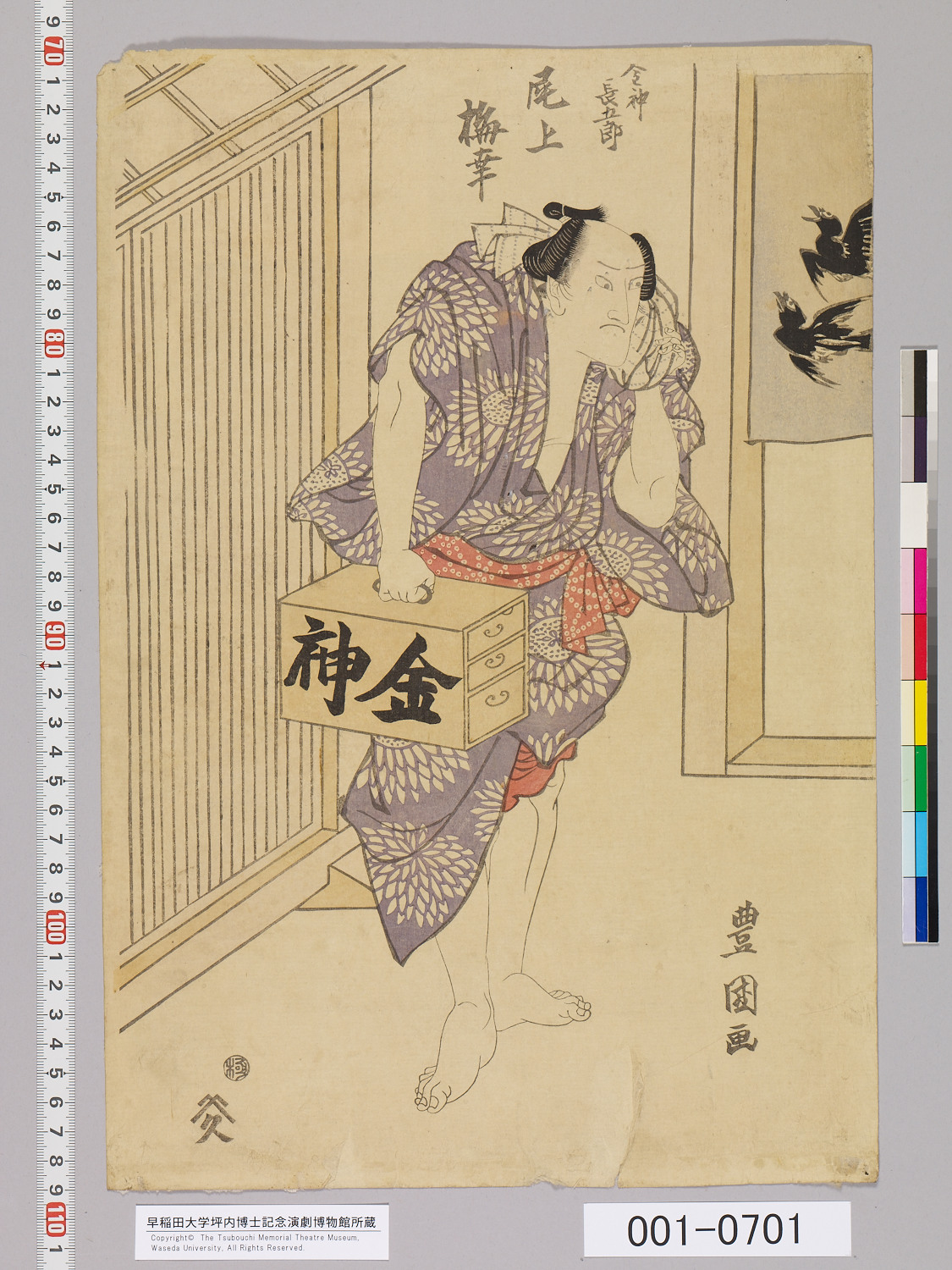
Konjin Chōgorō is a legendary figure in Japanese folklore, renowned as a formidable sumo wrestler. His tales often depict him engaging in supernatural feats, such as vanquishing demons and showcasing extraordinary strength.
In the realm of kabuki theatre, Konjin Chōgorō's character has been portrayed in various plays, though specific details about Ku Kyōdai Shōbu Katabira (句兄弟菖蒲帷子) remain unknown.
-
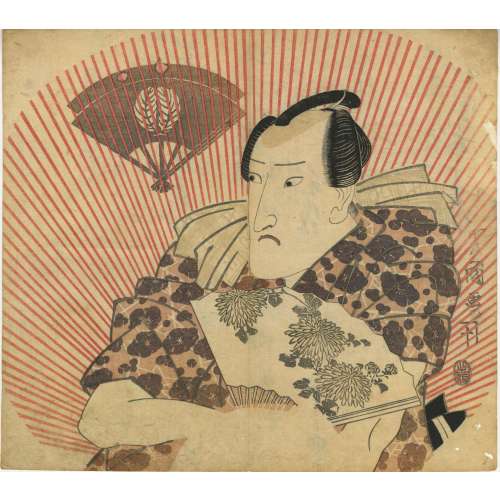 NEW
NEWArtist: Utagawa Toyokuni I [初代豊国] (Japanese, 1769–1825)
Signed: Toyokuni ga [豊国画]
Publisher: Kojimaya Jūbei [小嶋屋重兵衛] (Japanese, c. 1797–1869); seal [十]; Marks 06-014 | 264a
Date-Aratame Seal: 1822 (Bunsei 5, 文政五年)
Media: Print (Uchiwa-e, うちわ絵, fan print); 223 × 250 mm
Actor: Onoe Kikugorō III [三代目 尾上菊五郎] (Japanese, 1784–1849); other names: Onoe Baikō III (尾上梅幸), Ōkawa Hashizō I (大川橋蔵初代), Onoe Matsusuke II (二代目尾上松助), Onoe Eizaburō I (初代尾上栄三郎)
Half-length, three-quarter-view portrait of Onoe Kikugorō III, depicted without stage makeup. The actor wears a kimono patterned with plum blossoms (梅, ume), symbolising perseverance and longevity. A neck scarf with a 格子 (kōshi) pattern is visible, and he holds a folding fan (扇, ōgi) decorated with chrysanthemums (菊, kiku).
Above his head is the Onoe family crest (mon), embracing oak leaves on layered fans. This emblem, known as the crest of the Otowaya line, commemorates a shogunal gift of rice cakes wrapped in oak leaves, placed on a fan, and presented to Onoe Kikugorō I.
The background features a radiating red-line pattern, possibly representing the bamboo structure of an uchiwa fan. The absence of kumadori (歌舞伎隈取, kabuki makeup) suggests that the actor is not portrayed in a specific role.
In 1822, Onoe Kikugorō III performed at Kawarazaki-za before month 11 and at Ichimura-za and Nakamura-za afterwards.
The print has been backed for preservation with a sheet of paper featuring calligraphy, likely contemporary to the print itself. The backing paper appears to have been repurposed, a common historical practice in the Edo period, where discarded documents or manuscripts were reused to reinforce delicate prints.
Kunisada portrayed the same actor in 1815 as Rokusaburō, the Carpenter (Daiku Rokusaburō).



